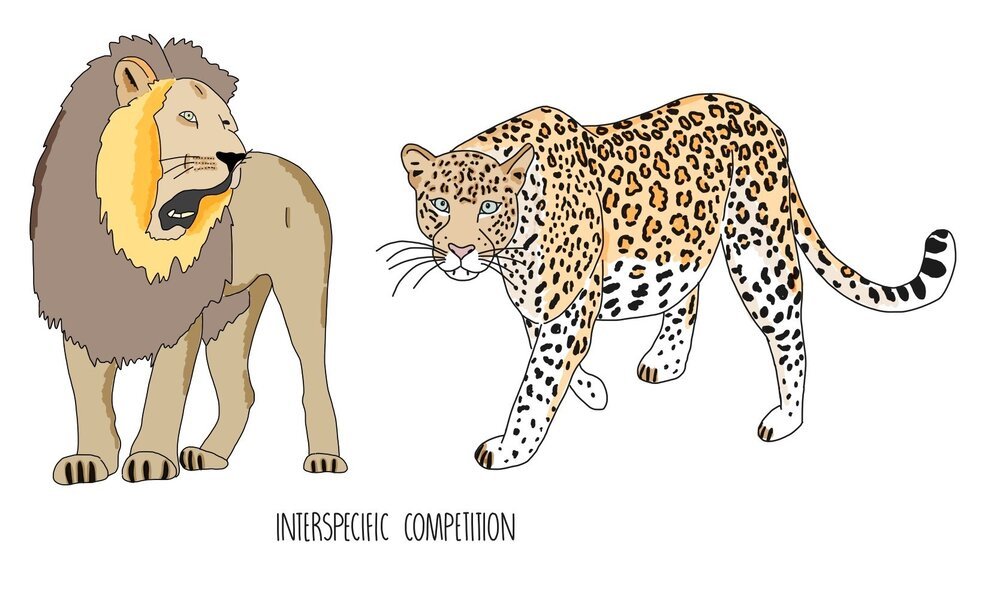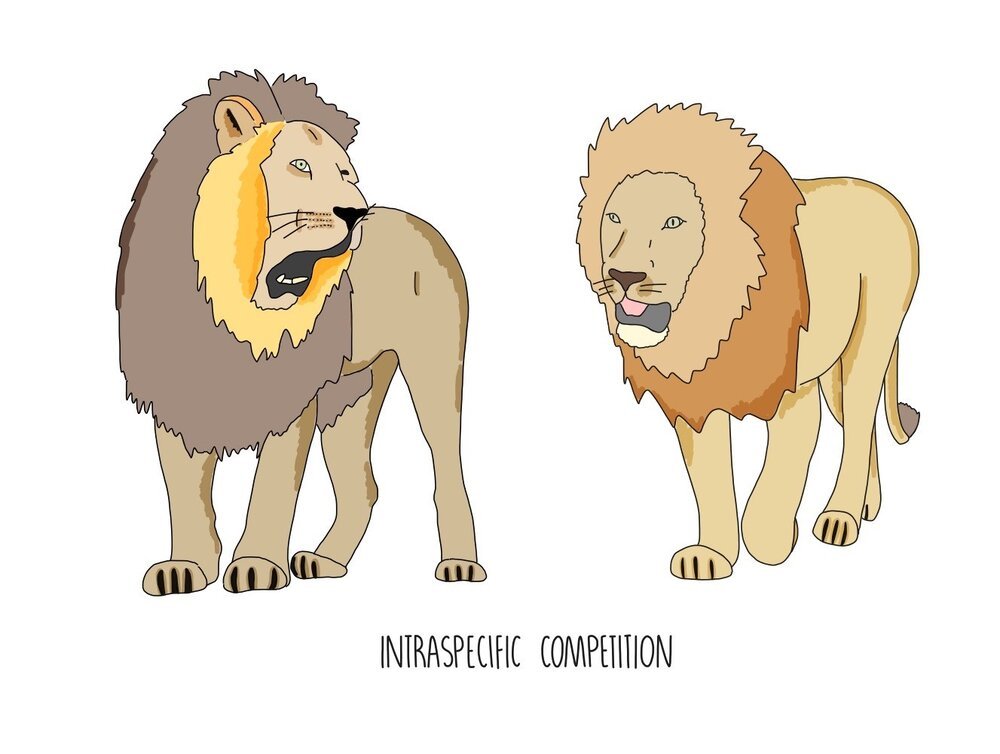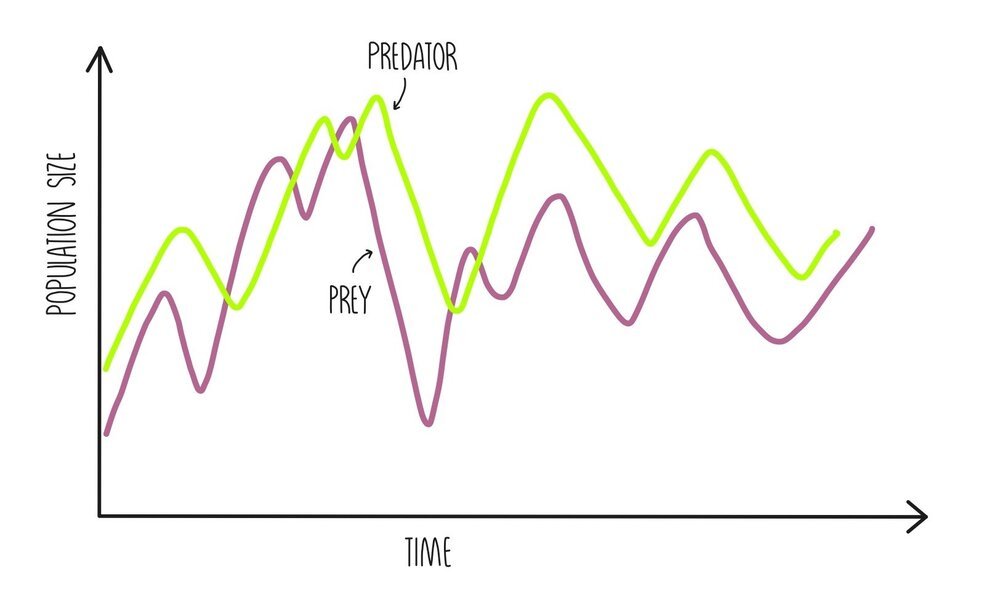Ecosystems and Energy Transfer
Ecology definitions
You need to be able to understand and define the following keywords which can be used to describe different groups within the environment:
Population: all the members of a single species which live in the same area
Habitat: the area in which an organism lives
Community: all the populations of different species which interact together in the same habitat
Ecosystem: a community of organisms and the habitat in which it lives (i.e. both the biotic and abiotic factors)
Factors which affect population size
The abundance (or population size) is defined as the number of individuals of one species in a particular area. It depends on both abiotic (non-living) and biotic (living) factors.
Abiotic factors, such as light intensity and water availability, affect population size because when these conditions are ideal, organisms can grow and reproduce successfully. When these conditions fluctuate, for example if the temperature of a habitat is too cold, the organisms in that habitat cannot grow as efficiently. More energy will be spent maintaining body temperature which means less energy will be available for growth and reproduction.
Biotic factors also affect species abundance. These include interspecific competition, intraspecific competition and predation.
Interspecific competition describes competition between species for the same resources. Interspecific competition means that resources have to be shared between the different species so there will be less available to both. This means both species will have less energy for growth and reproduction, so population numbers of both species will decrease.
Intraspecific competition describes competition for the same resources within the same species. When resources are abundant, the population size increases. This increases intraspecific competition since resources will need to be shared between more organisms, which cause population size to decrease. This pattern causes population numbers to fluctuate around a particular level which is the maximum stable population size that an ecosystem can support, which is known as its carrying capacity.
Predation affects the abundance of the prey species and vice versa. Whenever the population size of prey increases, this causes the population size of the predator species to increase because more food is available. The increase in the predator population causes a decrease in the prey population because there are more predators to feed on the prey. This causes a drop in the prey population size, which reduces the food availability for the predators, which in turn leads to a reduction in the predator population.
Factors which affect species distribution
Abiotic and biotic factors also influence the distribution of different species within a habitat. Species will only be able to live in parts of the habitat where abiotic conditions, such as food availability or soil pH, are ideal. Biotic factors, such as interspecific competition, means that only the better-suited species will live in an area because they will out-compete other, less-adapted species.
Investigating population size
Random and systematic sampling
Quadrats are square frames used to estimate population size.
Measuring the population size of a species by trying to count all of the individuals in the habitat would not only be pretty tricky but also considerably time-consuming. To save time, ecologists take a sample of the habitat and use that to estimate the size of the population in the whole habitat.
For species which don’t move, such as plants, quadrats are typically used. It is important that quadrats are placed randomly within the habitat to avoid bias. This can be done by using a tape measure to plot out the habitat as a grid and using a random number generator to plot coordinates. A large number of quadrats will be randomly placed throughout the habitat to ensure the data collected is reliable.
Sometimes it may be better to place the quadrats non-randomly - this is called systematic sampling. For example quadrats can be placed one next to each other along a transect. Systematic sampling is needed wherever there is an environmental gradient i.e. the abiotic factors change gradually from one end of the sample to the other.
Using transects
To see how the distribution of different species changes along a habitat, we use something called a transect, which is essentially a line placed from one part of the habitat to another. There are three different ways of using transects:
Line transect - a tape measure is placed along the line and any species which touch the tape measure will be recorded.
Belt transect - quadrats are placed along the transect one after another, so that each quadrat is touching
Interrupted transect - quadrats are placed at regular intervals along the transect
Once data has been gathered about the abundance and distribution of particular organisms, these can be displayed on a kite diagram. On kite diagrams, the abundance of each organism is shown by the thickness of the kite shape. The x-axis shows the distance along the transect, so indicates how that species is distributed through the habitat.
Succession
Succession describes the change in an ecological community over time, from a relatively sparse landscape to a stable community of several different plants and animals. There are two types of succession: primary and secondary. Primary succession is when an ecological community develops in the absence of soil (i.e. from bare rock). This may happen after a volcanic eruption which results in the formation of new rock or if the sea level lowers and exposes new land. Secondary succession is when an ecological community develops from a barren landscape in which soil is present. Secondary succession may happen after a forest fire, for example. Succession occurs in the following stages:
The first organisms to colonise an ecosystem are pioneer species, which includes things like moss, lichen and marram grass. There is no soil to begin with, therefore there’s nothing to absorb water. This means that the pioneer species are specially adapted live in dry, hostile conditions.
When the pioneer organisms die and decompose, they form a basic soil called humus. This makes the environment less hostile and changes the abiotic conditions. As soil forms and more water becomes available, other plant life will be able to survive here.
As those plants die and decompose, the soil becomes deeper and thicker. Larger plants, such as shrubs can now survive and biodiversity increases. The organisms which are best adapted to the changing ecosystem will out-compete and replace those which are less adapted.
Eventually, a stable community of plant and animal life is formed - this is called the climax community. The ecosystem is now supporting the largest and most complex community possible and the ecosystem stops changing significantly.
Energy transfer through ecosystems
Energy enters the food chain when producers absorb light energy and convert it into chemical energy during photosynthesis. The energy is used for the plant for growth and becomes biomass (biomass describes any living matter). When primary consumers eat the plants, the energy (and biomass) is transferred to the next trophic level. The energy is eventually passed onto secondary and then tertiary consumers.
Only a small proportion (around 40%) of the energy at one trophic level is passed on to the next. The rest is lost in the following ways:
Not all the light energy that hits the plant will be absorbed - some will hit non-photosynthetic parts of the plant (e.g. the tree trunk). Of the light energy that does hit a photosynthetic pigment, not all of it can be absorbed because it is the wrong wavelength (e.g. chlorophyll pigments are unable to absorb green parts of the visible spectrum, which is why they appear green to us).
Not all parts of an organism are eaten e.g. bones, beaks and roots. The energy is transferred to decomposers.
Consumers may not be able to completely digest the organism - e.g. humans are unable to completely break down plant cell walls and is converted into faeces. The energy is passed onto decomposers.
Of the 40% of total energy that is passed onto the next trophic level, only a quarter (10%) is converted into biomass and will be available to the next trophic level. The remaining 30% is used in respiration, movement and maintaining body temperature. This explains why food chains rarely exceed four or five trophic levels - there isn’t enough energy remaining by the time it is transferred to the tertiary consumer.
Measuring energy transfers between trophic levels
The official method of measuring energy transfers between trophic levels is to essentially roast the organisms in the oven to dehydrate them, weigh them and calculate the difference in mass between organisms at different trophic levels. That’s all fine for plants but not such a nice experiment where animals are involved. For this reason, scientists would usually estimate the dry mass of animals instead. Here’s the method anyway:
- Choose the area that you want to sample - e.g. a m2 area of woodland.
- Dry the different organisms in the food chain in an oven until their mass becomes constant - at this point you can be sure that all the water has been removed and you're left with only the dry mass (biomass).
- Multiply the results of the sample by the size of the total area (e.g. to work out the biomass of that organism in 1500 m2 of woodland.
- The difference in biomass between the trophic levels is the same as the amount of biomass transfer (or energy transfer) between the organisms.
The limitations with this approach are that it assumes that each consumer only consumes one type of organism - it wouldn’t work for consumers which feed on multiple food sources.
Net productivity
Biomass is the amount of energy that is available to the next trophic level - it can also be referred to as net productivity. You can think of this as the amount of weight an organism has been able to pack on - the fatter the organism, the more food (and energy) will be available for the organism that is going to eat it. Net productivity is calculated by taking the gross productivity (all the energy consumed by the organism) and subtracting the amount lost in respiration.
Whenever plants are involved, net productivity is referred to as Net Primary Productivity (NPP) because they are the first organisms in the food chain. It is calculated by taking the Gross Primary Productivity (GPP) and subtracting the energy used in plant respiration.
We can also calculate how efficient energy transfer is by dividing the net productivity by the total amount of energy taken in by the organism. This number is then multiplied by 100 to convert it into a percentage.








